Early views of Hastings harbour captured in time
This article contains affiliate links. We may earn a small commission on items purchased through this article, but that does not affect our editorial judgement.
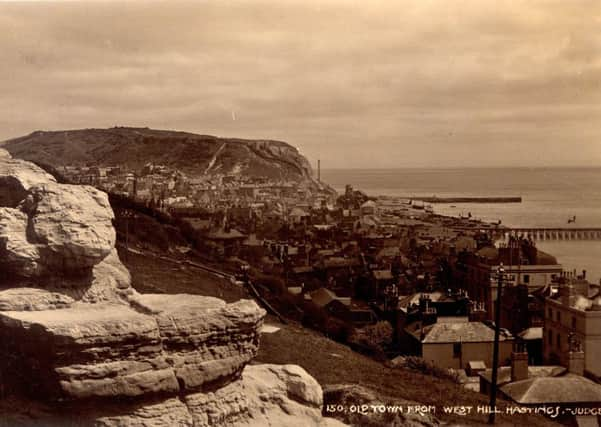

The building of Hastings Harbour started in 1897 and it was the discovery of a mud-filled channel in the seabed in the path of the main breakwater that spelled the end of the project and only part of the western arm was ever built.
But but as these postcards show, the effect of the partially completed works on the shoreline has been considerable.
Advertisement
Hide AdAdvertisement
Hide AdThe longshore drift, a sea current that runs eastward dragging shingle with it has created a shingle bank against the harbour remains and now extends back as far west as White Rock where it meets Sidney Little’s promenade extensions of the 1930’s so that sea in some places is hundreds of metres from the shoreline of 120 years ago.
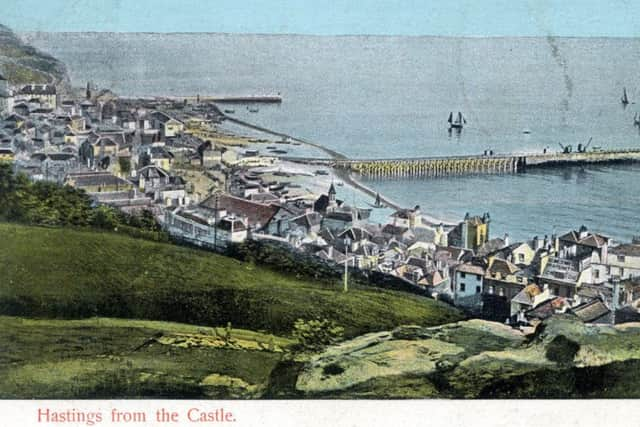

The construction of groynes, originally wooden but later in stone or concrete an later still of massive boulders is designed for the same function, by trapping shingle on its eastward journey it protects the shore and promenade against the ravages of the waves. The shingle that does escape seems to end up eventually building Dungeness.
The main part of the harbour was built in monolithic concrete a distance below the low water line with timber tresselwork forming a bridge to above high water line and carrying the service (Narrow gauge) railway onto the harbour wall. Over the years the longshore drift reduced the gap to the shore eventually closing it in the 1960’s and the beach advanced along the western side of the harbour arm reducing its effective length and increasing the stonebeach.
All illustrations are from Ion Castro’s own collection and he can make available copies of many of the historic images used in this series.
Advertisement
Hide AdAdvertisement
Hide AdThere’s more local history on Ion’s website, www.historichastings.co.uk.
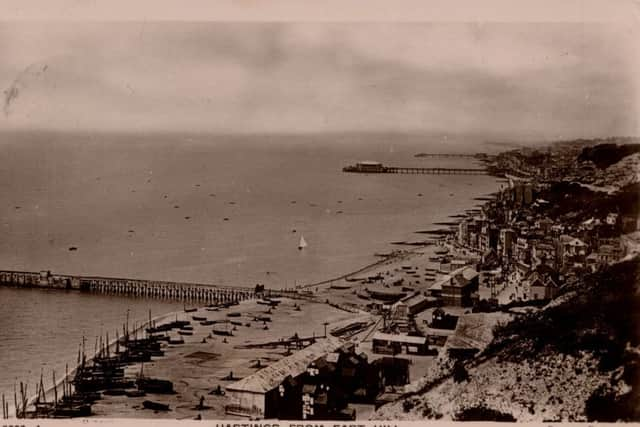

Captions
Hastings (+ tram)
This hand tinted postcard is unposted but probably dates from around 1906 is dominated by the harbour arm and extended eastern groyne with the trellis work that was supposed to lessen the inhibiting effect of the breakwater by allow the beach to flow east ward and clearly shows the extent of the shingle gain since the picture was taken. The picture show two of the recently introduced trams and a horse bus that they forced out of business. The tram tracks were both on the seaward side of the promenade and this caused problems as motor-car usage and the rule of the road, driving on the left, was introduced. The roofs of the original White Rock Baths can be seen in the centre of the picture.
Hastings from East Hill
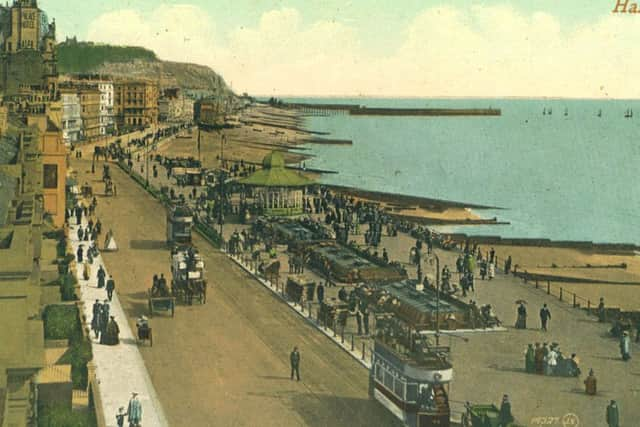

Postmarked 31/3/1907. This postcard is from the short lived firm of Davidson Brothers (active 1901 – 1911) of London who were not photographers but were a publisher of continuous toned lithographic and tinted real photo postcards. They also published comics, holiday cards, moonlight scenes, art reproductions, and stage portraits. The beach has now built up to beyond the left-hand edge of the picture and St Leonards Pier can be seen in the distance.
26 Old Town from West Hill, Hastings
This card from an uncredited publisher is postmarked 3/8/1928 and already the beach has almost reached the concrete part of the harbour arm and damage toward the seaward end is already evident. The extension to the eastern groyne had been removed in 1911 and the boating lake is yet to be built.
150 Old Town from West Hill, Hastings
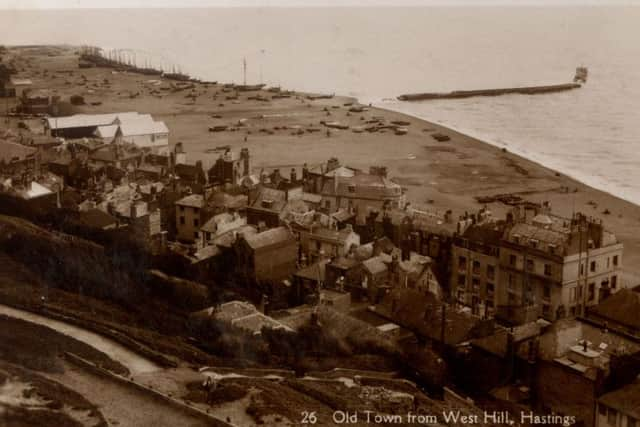

Advertisement
Hide AdAdvertisement
Hide AdPostmarked 29/7/14 this card from Local firm Judges must actually pre-date the storms of late 1911 because the harbour’s timber staging is still complete. The enigmatic ‘St George’s Churchyard’ can clearly be seen on the top of the East Hill as can the ‘dust destructor’ chimney below the cliff.
201 “Coming Ashore” Hastings
The publisher is uncredited and the card is unposted but must date from the early 1930’s because the damage to the harbour isn’t yet that severe and the shingle is still advancing. Enlargement of the original does not completely reveal the registration numbers of the fishing boats but their ‘lute sterns’, designed to minimise the effect of the waves when the boats come ashore, can be clearly seen.
123 Old Hastings from West Hill
Uncredited publisher but postmarked August 3rd 1911, the beach is extending and already being used to dry the washing that was taken in by fishermen’s wives to supplement the family income. The extension built on top of the eastern groyne and removed in 1911 can clearly be seen.
Hastings from the Castle
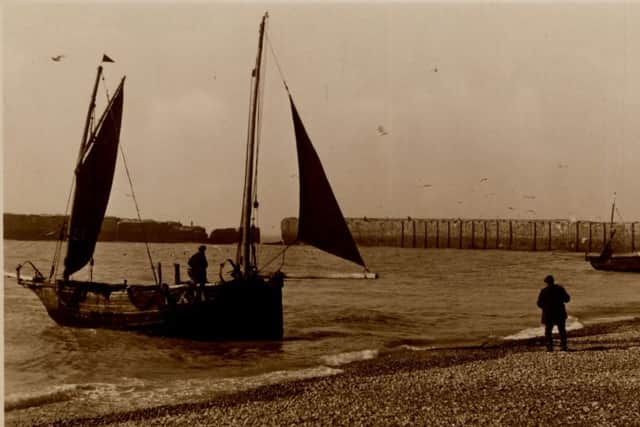

This hand-tinted card is postmarked 11/8/1904 and shows the original shoreline although the colourist has tinted the beach blue. The old Lifeboat house with its ‘steeple’ and demolished in 1959 for road-widening can be seen in the centre of the picture.
Advertisement
Hide AdAdvertisement
Hide AdDon’t miss out on all the latest breaking news where you live.
Here are four ways you can be sure you’ll be amongst the first to know what’s going on.
1 Make our website your homepage at www.hastingsobserver.co.uk
2 Like our Facebook page at www.facebook.com/hastingsobserver
3 Follow us on Twitter @HastingsObs
Advertisement
Hide AdAdvertisement
Hide Ad4 Register with us by clicking on ‘sign in’ (top right corner). You can then receive our daily newsletter AND add your point of view to stories that you read here.
And do share with your family and friends - so they don’t miss out!
The Hastings Observer - always the first with your local news.
Be part of it.